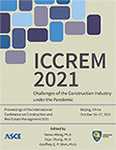An Investigation on the Polycentric Spatial Structure in Shenzhen, China
Publication: ICCREM 2021
ABSTRACT
Shenzhen has implemented polycentric urban planning since it founded. However, it is not clear how the spatial structure of Shenzhen is developing. Based on the mobile phone data, we measure Shenzhen’s spatial structure in 2019 according to the concentration of employment and residence. The results show that: (1) Shenzhen’s spatial structure is highly polycentric; (2) in terms of residence, Shenzhen has formed a “2+2+1” polycentric structure: “Futian-Luohu,” “Longhua” two main centers, “Bao’an,” “Qianhai” two subcenters, and “Buji” one group center; and (3) in terms of employment, Shenzhen has formed a polycentric structure of “2+1+1”: two main centers of “Futian-Luohu” and “Qianhai,” one subcenter of Longhua, and “aviation city” one group center. It is found that urban planning has played an important role in the formation of urban spatial structure in Shenzhen by comparing the results with the master planning of Shenzhen.
Get full access to this article
View all available purchase options and get full access to this chapter.
REFERENCES
Burger, M. J., Goei, B. D., Laan, L. V. D., and Huisman, F. J. M. (2011). “Heterogeneous development of metropolitan spatial structure: evidence from commuting patterns in English and Welsh city-regions, 1981-2001.” Cities, 28(2), 160–170.
Giuliano, G., and Small, K. A. (1991). “Subcenters in the Los Angeles region.” Regional Science and Urban Economics, 21(2), 163–182.
Huang, D., Liu, Z., Zhao, X., and Zhao, P. (2017). “Emerging polycentric megacity in China: an examination of employment subcenters and their influence on population distribution in Beijing.” Cities, 69, 36–45.
Kane, K., Hipp, J. R., and Kim, J. H. (2018). “Los Angeles employment concentration in the 21st century.” Urban Studies, 55(4), 844–869.
Liu, X., Derudder, B., and Wang, M. (2018). “Polycentric urban development in China: a multi-scale analysis.” Environment and Planning, 45(5), 953–972.
Liu, X. J., and Wang, M. S. (2016). “How polycentric is urban China and why a case study of 318 cities.” Landscape and Urban Planning, 151, 10–20.
Lv, Y., Zheng, X., Zhou, L., and Zhang, L. (2017). “Decentralization and polycentricity: spatial changes of employment in Beijing metropolitan area, China.” Sustainability, 9(10).
McDonald, J. F., and Prather, P. J. (1994). “Suburban employment centres: the case of Chicago.” Urban Studies, 31(2).
Qin, B., and Han, S. S. (2013). “Emerging polycentricity in Beijing: evidence from housing price variations, 2001-05.” Urban Studies, 50(10), 2006–2023.
Siedentop, S., Fina, S., and Krehl, A. (2016). “Greenbelts in Germany’s regional plans: an effective growth management policy?” Landscape and Urban Planning, 145, 71–82.
Small, K. A., and Song, S. (1994). “Population and employment densities: structure and change.” Journal of Urban Economics, 36(3), 292–313.
Taubenboeck, H., Standfuss, I., Wurm, M., Krehl, A., and Siedentop, S. (2017). “Measuring morphological polycentricity: a comparative analysis of urban mass concentrations using remote sensing data.” Computers, Environment and Urban Systems, 64, 42–56.
Vasanen, A. (2012). “Functional polycentricity: examining metropolitan spatial structure through the connectivity of urban sub-centres.” Urban Studies, 49(16), 3627–3644.
Yue, W., Liu, Y., and Fan, P. (2010). “Polycentric urban development: the case of Hangzhou.” Environment and Planning, 42(3), 563–577.
Information & Authors
Information
Published In
Copyright
© 2021 American Society of Civil Engineers.
History
Published online: Dec 9, 2021
Authors
Metrics & Citations
Metrics
Citations
Download citation
If you have the appropriate software installed, you can download article citation data to the citation manager of your choice. Simply select your manager software from the list below and click Download.
